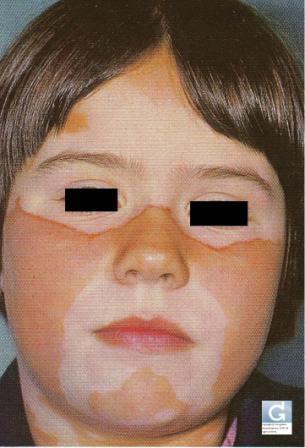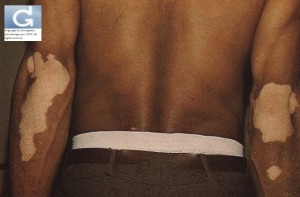Vitiligo
Dr Christophe Hsu – dermatologist. Geneva, Switzerland

Vitiligo
What is vitiligo ?
- Vitiligo is a skin disorder which presents as white spots and patches on the skin.
- This is due to a progressive loss of the pigment, melanin, which gives us our skin colour. The loss of pigment occurs when pigment cells (melanocytes) are destroyed and melanin cannot be produced.
- Vitiligo is not contagious.
- Common sites affected include:
- Bony surfaces – back of hands and fingers, elbows and knees.
- Around body orifices – around the eyes, mouth and nose.
- Body folds – armpits and groins.
- Others areas – legs, wrists, nipples and genitalia.
- Vitiligo may also develop over an area of injury such as a cut or burn.
- Hair within the affected patch may be white too.
What causes vitiligo ?
- The cause of vitiligo remains unknown.
- However persons with vitiligo have a higher incidence of association with :
- diabetes mellitus
- thyroid disease
- other autoimmune diseases.
Can vitiligo be treated ?
Yes. Several forms of treatment are available but the response to treatment varies with each person and site affected.
Some chemicals can destroy the skin pigment cells leading to vitiligo-like skin lesion. Avoidance of contact with such chemicals is important. Some bleaching creams contain such chemicals.
How can vitiligo be treated ?:
- Corticosteroid creams
- Potent corticosteroid creams are effective in some patients.
- Regular monitoring by your doctor is necessary to prevent side effects.
- Psoralen photochemotherapy(PUVA)
- PUVA is a combination treatment involving the use of a drug called Psoralen(P) and then exposing the skin to UltraViolet light A (UVA) – hence the tern PUVA.
- Psoralen makes the skin temporarily sensitive to UVA which forms part of natural sunlight.
- Psoralen can either be used in the lotion form or as tablets.
- When the lotion is used with subsequent exposure to UVA, the treatment is known as topical PUVA.
- If the oral tablet is used, it is called oral PUVA.
- Generally, topical PUVA is used to treat vitiligo affecting limited skin areas.
- Patients treated with PUVA must be prepared to undergo therapy for a year or longer for maximal results.
- Close medical supervision is necessary.
- Use of psoralen lotion followed by exposure to sunlight may be risky and unreliable as the amount of UVA in sunlight varies from day to day. Artificial sources of UVA used under proper supervision are preferred.
- Camouflage cosmetics
- Some cosmetics can provide very good colour match and camouflage and are particularly useful for white patches on the face and back of the hands.
- A special tanning chemical (dihydroxyacetone) which does not require sunlight, is also available to camouflage the patches of vitiligo.
- Sunscreens
- Areas affected by vitiligo are very prone to sunburn as they are devoid of protective pigment.
- It is advisable for patients to used broad spectrum high protection factor sunscreens on affected areas which may be exposed to sunlight.
Contributors:
Dr Christophe HSU – dermatologist. Geneva, Switzerland
National Skin Centre. Singapore
Español Italiano Português Tagalog Deutsch русский язык 日本語
Category : cause - Modifie le 11.29.2009Category : causes - Modifie le 11.29.2009Category : étiologie - Modifie le 11.29.2009Category : etiology - Modifie le 11.29.2009Category : traitement - Modifie le 11.29.2009Category : traitements - Modifie le 11.29.2009Category : treatment - Modifie le 11.29.2009Category : treatments - Modifie le 11.29.2009Category : vitiligo - Modifie le 11.29.2009



